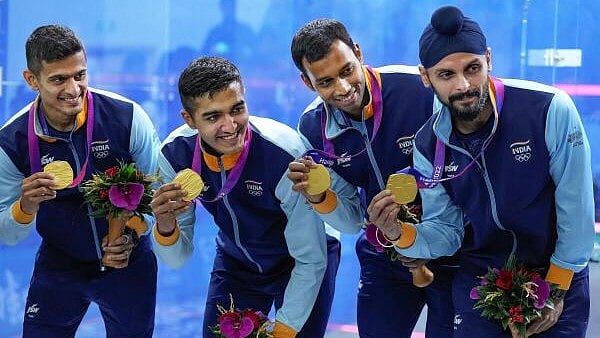
Gold medallists India's Saurav Ghosal, Abhay Singh, Mahesh Mangaonkar and Harinder Pal Sandhu pose for photos during the presentation ceremony of the Squash Men's Team event at the 19th Asian Games, in Hangzhou.
Credit: PTI File
What is common between External Affairs Minister S Jaishankar and former RBI Governor Raghuram Rajan? Besides being popular global Indians, both are known to turn to the game of squash in their spare time. A sport enjoyed globally for its intensity, squash, which is physically exhilarating, technically fascinating, and mentally stimulating, is preparing for its debut at the LA 2028 Olympics.
Many will long remember Abhay Singh’s mind-boggling heroics against Pakistan in the Men’s Squash Team Event finals at the 2023 Hangzhou Asian Games. Twice on the brink of defeat with his team at 1-1, Singh went on to win India a gold medal. Since then, he has won his second national crown in 2024, and has started 2025 with a bang winning the Arjuna Award. With Singh’s teammates on a roll — Ramit Tandon breaking into the world’s top-30, 2023 National Champion Velavan Senthilkumar breaking into the top-50, and Veer Chotrani reclaiming his place in the top-100 — Indian squash is at an inflection point.
Another promise for India’s squash team is the 16-year-old Anahat Singh. Mentored by 2022 Commonwealth Games bronze medalist Saurav Ghosal, Delhi-based Anahat Singh just won her third title at the prestigious British Junior Open. She also bagged her second consecutive national crown, and broke into the world’s top-100 women’s players in 2024.
Anahat Singh’s blossoming rivalry with her India teammate Akanksha Salunkhe, runner up at the 2024 Indian Women’s National Championships and a top-70 world ranking player, has become a pulsating treat for squash fans. With Joshna Chinappa, a former world number 10, and Tanvi Khanna, a former India number 2, making comebacks from career-threatening injuries, Indian women’s squash is gearing up for a stellar showing.
The men’s and women’s teams achieved their best-ever finishes, fifth and seventh respectively, at the recently concluded World Squash Team Championships in Hong Kong. Yet, how many people in India know of the above names? Let alone having ever experienced seeing or playing this adrenaline-packed sport themselves.
Lack of awareness, visibility, investment, infrastructure, and, thereby, grass-roots interest are some of the issues that have marred squash’s growth in India. This is especially true given the sport’s roots in elite urban sports clubs across major cities or closed-door complexes and competitions of the Indian armed forces. Herein lies a familiar story of squash’s difficult journey as a global sport, but more so as an Indian enterprise.
Steered by the Squash Rackets Federation of India, slowly, but surely, change has come. This has been triggered by major development efforts like the India Cements National Squash Academy in Chennai, the Dhampur Sugar Mills’ interest and investment, JSW’s sports programmes offering infrastructure and training, among others. Some of the great names currently inspiring the ecosystem through their academies are former Harvard University coach Satinder Bajwa, five-time national champion Ritwik Bhattacharya, former player Amjad Khan, Kolkata-based coach Dalip Tripathi, Pro-Coach national champion Abhinav Sinha, junior Asia-level prodigy Ravi Dixit, and junior Indian team coaches Surbhi Misra and Dhruv Dhawan.
Some state governments have chipped in at various stages of progress and achievement. An ‘inflection point’, however, will need all hands on deck.
It’s time for Indian squash to get the boost that takes it to global standards. Standards set by Egypt’s unmatched dominance of the sport in the last two decades; thanks to its government’s prioritisation, heavy private investments, and a generation-after-generation yielding club-community-competition environment. At the Asian level, Malaysia has set the standard. The United States’ college squash system, which attracts the world’s best junior talent and senior coaches, is a good example to follow. So are England’s spoke-and-hub national and county-wide development programmes that have roped in retired legends. China too has sanctioned the building of massive, modern squash complexes, and is offering lucrative deals to international coaches help drive its programmes.
India has some critical gaps to fill when it comes to finding range and depth across its squash ecosystem. As any systemic endeavour entails, the end is a sum of its parts. This means a massive public-private push, through the sports ministry and by private individuals and enterprises offering largesse. From schools and universities building competitive squash programmes, to city and state-level coaching camps and academies, to a national squash league, to big-ticket international tourneys — much is on the cards, waiting to take-off.
Squash’s future in India is now no more a case of when, where, or what; but of who, and how much. With the inspiration of the greatest sporting stage in the world for the first time, the 2028 Olympic Games, there will never be a better time to seize the moment.
(Rahul Batra works on digital technology and global affairs, and has played on the national squash circuit.)
Disclaimer: The views expressed above are the author's own. They do not necessarily reflect the views of DH.